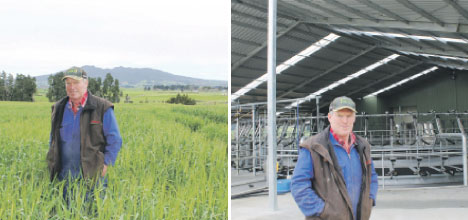Maize has grown continuously on the paddock called ‘Near Flat' on Cranleigh farm for 51 years – and in the last decade has produced yields above the district average.
The secret, says Alan Henderson of Cranleigh near Te Awamutu, is looking after the soil by keeping animals off it.
In a field of barley – Alan Henderson with a crop he hopes will become more common on Waikato farms. The new rotary dairy at Cranleigh was completed in time for this season's milking.
'That paddock hasn't been grazed for the last 15 years, and apart from maize, has only ever grown a cover crop. Its yield has been 15 to 19 tonne of grain maize per hectare. The target is 20 tonnes of grain per hectare.
'Pugging caused by livestock damages the soil structure and I estimate it takes about five years for the soil structure in this area to recover after being grazed. The underlying message is that yield will be lower from soil which has been damaged.”
Alan's management of the 4 ha paddock differs from that of his father Russell, who began using it for cropping in the 1960s, but also grazed it. 'He still doesn't agree with what I'm doing and reckons I should be using every blade of grass to feed the cows, not just as a cover crop.”
However, Alan says he's more interested in the work the cover crop does in retaining and enhancing the soil structure and life, than using it to feed animals.
Data
Alan has 20 to 30 years of data about the performance of the paddock, including when maize was sown each spring. 'It turns out October 12 is the most common planting date but I don't just stick to that. Weather and soil temperature are taken into consideration.”
Alan is a board member of the Foundation for Arable Research and has had up to 12 different research projects undertaken at Cranleigh.
One of the aspects of the farm's management, which no doubt makes it ideal for research, is the fact that Alan has his own cultivation and sowing machinery and equipment. This means he can prepare and sow crops at the optimum time. 'At times there is only 24 to 72 hours between harvest and planting the next crop to make the best use of heat units, so the optimum yields can be obtained.”
His aim is to produce 40 to 50 tonne of dry matter per hectare across the cropping area of the farm – and timing is crucial in achieving the goal, so Alan has invested in his own gear rather than use contractors.
While Near Flat is his best performing maize paddock, Alan also grows crops on other parts of the 270 ha property near Te Awamutu. 'Twenty per cent of the dairy platform is in some sort of summer crop, including chicory and turnips.” Dairy shed effluent is used on the cropping paddocks, including Near Flat.
Cropping helped Cranleigh get through last summer's drought. 'Despite the drought, this was the first dry summer where I felt comfortable about our feed supply. In the previous two droughts we suffered quite badly and had to dry cows off early.”
Divisions
Cranleigh milks 650 cows, raises 600 to 700 calves and sells off about one-third of the maize grain and the same amount of maize silage, which it grows. It also brings in 35 per cent of supplementary feed, including some palm kernel; and the property also runs 50 to 80 sheep.
'Each division of the farm is treated as a separate business model; and although there is some sharing of plant, equipment and staff, each has to pay its way individually. Keeping each sector as a separate entity enables Alan to gauge its performance, and profits or losses are not masked by other sectors.
The Henderson family doesn't shy away from change in order to keep Cranleigh financially viable. In the past it has been a sheep farm, a dry stock farm, a cropping farm, and even for a time, it ran deer. Today, it is a mixed dairy and cropping farm with an established nashi, apple and kiwifruit orchard in one corner, leased to an orchardist.
Twenty-five years ago maize at Cranleigh was harvested using the cribbing method of putting cobs in baskets to dry. 'We were the first growers in the Waikato to do cribbing and the corn was used for corn flakes and corn chips. But humidity and disease in the Waikato made it tough going to achieve the quality required.” Now Alan employs contractors to harvest both the grain and silage crops.
As well as FAR researchers, those from seed companies also use Cranleigh for trials and Alan is happy to oblige.
'On one hand you could say some of the trials which don't turn out so well cost me in terms of lost production. But on the other hand I see it as one way of giving back to the industry, and I also benefit from being involved with scientists.”
Innovator
Alan is an innovator with a voracious hunger for knowledge. Working with scientists on his farm and through FAR is like having a university education without leaving home, he says. Alan often uses what he learns to take research even further.
'I get to see the likely results before the research is complete and that gives me the confidence to try something different myself to see what happens.”
In that act, Alan says he is not alone. 'Farmers are the best researchers and they are excellent observers, who often have a lot more instinctive understanding of what is happening on their properties and with their animals than they consciously realise.
'Farmers are there to look after the environment and soil structure and they don't set out to degrade the environment.”
Alan and wife Joy have three children aged between 16 and 20. Each has worked on the farm, including raising 200 calves during their last year at primary school, giving them a taste of the realities of farming, (including early mornings) and the financial rewards possible.
'We've set in place a family business so that they can be as involved as they want to be, either hands-on or in an administrative role,” says Alan.
It's not surprising that someone so focused on farm performance, and research and development, should also be astute about the future of the property in which he has invested – and he continues to invest, so much time, energy and thought.



0 comments
Leave a Comment
You must be logged in to make a comment.